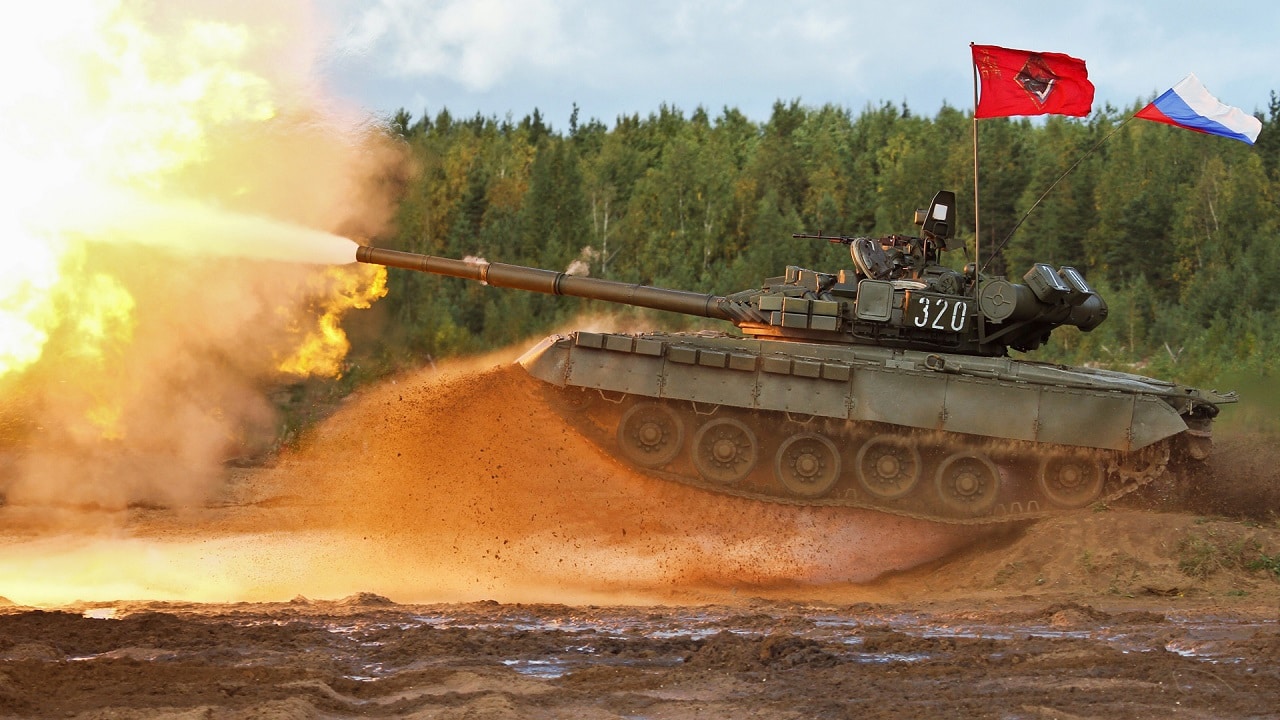Key Points: Russia’s T-80 tank, intended as an advanced successor to the T-64, is described as an expensive failure and “steel coffin,” particularly highlighted by heavy losses in Ukraine.
-Unlike typical Soviet designs, it was complex and featured a fuel-guzzling gas turbine engine limiting its range.
-After a poor debut in Chechnya, it was largely sidelined until deployed en masse in Ukraine following attrition of other models, where it suffered similar high losses due to inherent vulnerabilities and flawed Russian tactics.
-With hundreds lost and its main factory now in Ukraine, the T-80 symbolizes Russia’s military disappointments.
Russia’s T-80 Tank: A Really Expensive Steel Coffin
The war in Ukraine has not gone well for Russia or its armored forces. They have lost about 3,000 tanks, destroyed or abandoned during what Putin calls the “special military operation.”
Most of the tanks lost, especially early in the conflict, were the T-72s and T-90s, but the T-80 has arguably fared worse. Despite the tanks being obsolete, Russian tactics were poor, bordering on criminally negligent, as they were overconfident, ill-trained, and ill-prepared for the hard defense that Ukrainian forces have continued to deploy.
The much-ballyhooed Russian “modernization” of its military was nowhere to be found. Russia said it had totally revamped its armed forces and that Junior leaders and NCOs would now resemble United States and NATO forces. It was a total fabrication. Russia itself contradicted the “Gerasimov Doctrine.”
Battalion Tactical Groups (BTGs) (an idea from the 1990s) were introduced in 2012 to generate effective combat power from brigades by concentrating contract personnel into a battalion-sized grouping. The factor that is supposed to make this work is that Battalion commanders, company commanders, and lower-level officers show initiative and react dynamically to the evolving battlefield situation.
Instead, little initiative has been shown, and command has reverted to the old-fashioned top-down structure. There also appears to have been a reversion to the more negative characteristics of the Soviet military system with rigid adherence to an operational plan, even when the reality of circumstances on the ground has made the plan invalid.
BTGs generally comprise a tank or infantry battalion reinforced with armor or infantry and with artillery, air defense, electronic warfare, and other combat support assets. They failed, and as losses mounted, the Russians began to look more and more like their Soviet predecessors.
The T-80 Tank Program Was Very Unlike The Soviet/Russian Model
The Russian T-80 tank program sprang from the 1964-introduced 38-ton T-64, which featured a compact engine arrangement; an auto-loader for its 125 mm smoothbore cannon, which could fire shells or anti-tank missiles; smaller all-steel rollers in place of the big-wheeled Christie suspension that had reached its practical limit in the T-62; and composite armor made of layers of steel and ceramic compound.
The T-64’s prototype and production models differed, and the tank had several issues. The T-64’s auto-loader had a dangerous tendency to “eat” the left arms of inattentive gunners inside the cramped turrets.
Another flaw was where rounds had to be stored: outside the turret mounting ring but within the crew compartment. This placement would be deadly for all hands in the event of a hit, which is why so many destroyed Russian tanks have had their turrets blown off.
The T-80 tanks resulted in two things the Russians have always eschewed in their tank designs: they were expensive and complex. The tank was fast, going upwards of 70 kilometers per hour, but its SG1000 gas turbine engine was a fuel guzzler that limited its range.
Like all Soviet tank designs, the 125 mm 2A46H1 Rapira smoothbore cannon couldn’t depress or elevate very much, which was a significant factor in urban warfare.
The T-80 costs three and a half times the cost of a T-64.
The T-80s Combat History is Poor
After a horrible start when first used in Chechnya, exacerbated by poor training of the crews, the T-80 was held out of the second Chechnya war, the 2008 Russo-Georgian conflict, or the 2014 Russo-Ukrainian war.
In 2022, however, after heavy attrition on the T-72s and T-90s in the invasion early in the conflict, the Russians were forced to send their T-80s into the fray. They also suffered heavy losses for the same reasons as their fellow tank models.
Since the war began, the Russians have already lost hundreds of T-80 tanks. The T-80’s survivability problems are a common theme.
Some reports have them losing as many as 1000 T-80s. The main plant for building T-80s was in the Russian city of Kharkov, now the Ukrainian city of Kharkiv—the same city known by its Ukrainian name.
The Ukrainians use the T-80, too, but it has taken a toll on the Russians because they know its weaknesses, too. The T-80s have been an embarrassing disappointment for the Russian military.
About the Author: Steve Balestrieri
Steve Balestrieri is a 19FortyFive National Security Columnist. He served as a US Army Special Forces NCO and Warrant Officer. In addition to writing for 19FortyFive, he covers the NFL for PatsFans.com and is a member of the Pro Football Writers of America (PFWA). His work was regularly featured in many military publications

